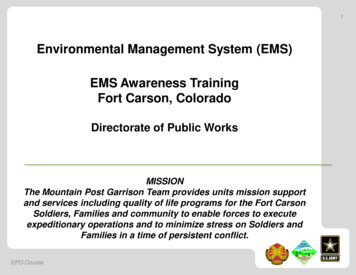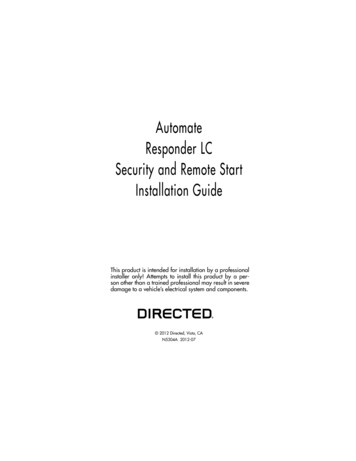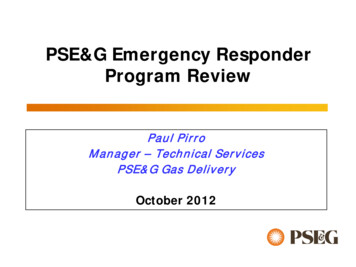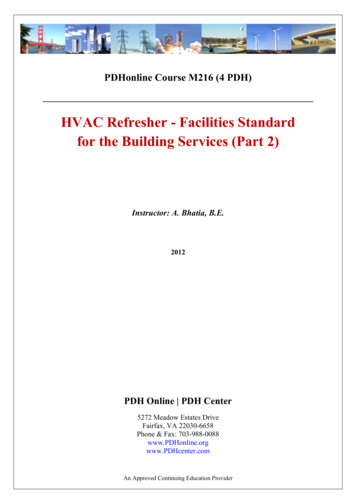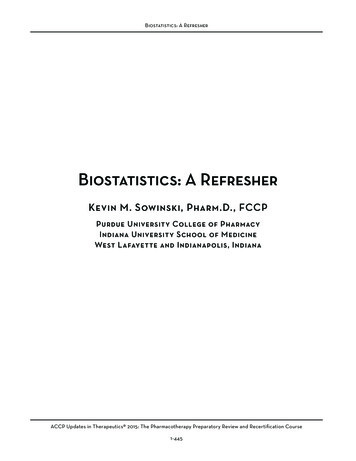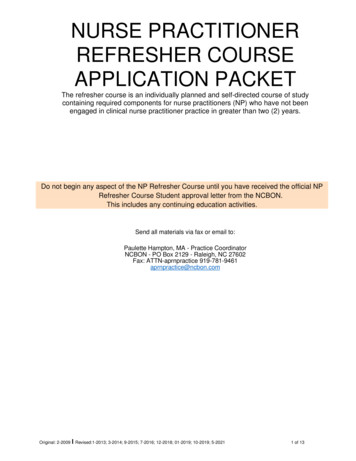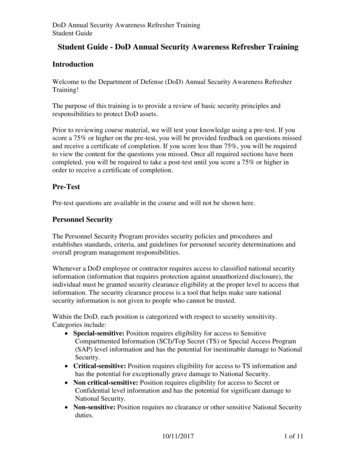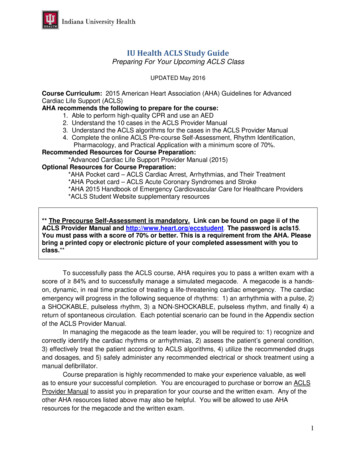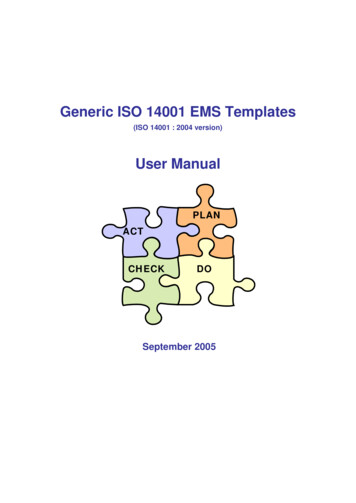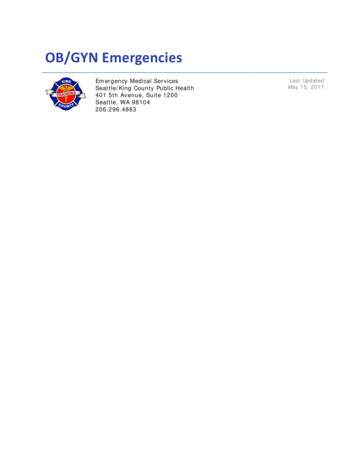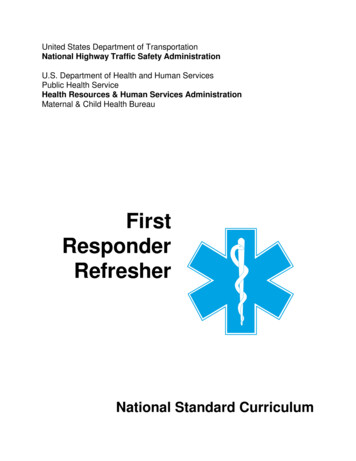
Transcription
United States Department of TransportationNational Highway Traffic Safety AdministrationU.S. Department of Health and Human ServicesPublic Health ServiceHealth Resources & Human Services AdministrationMaternal & Child Health BureauFirstResponderRefresherNational Standard Curriculum
First Responder Refresher: National Standard CurriculumProject DirectorWalt Alan Stoy, PhD, EMT-PDirector of Educational ProgramsCenter for Emergency MedicineResearch Assistant Professor of MedicineUniversity of Pittsburgh School of MedicinePrincipal InvestigatorsGregg S. Margolis, MS, NREMT-PAssociate Director of EducationCenter for Emergency MedicineThomas E. Platt, BA, NREMT-PCoordinator of EMS EducationCenter for Emergency MedicineMedical DirectorsNicholas H. Benson, MD, FACEPChair, Department of Emergency MedicineEast Carolina University School of MedicineMedicineHerbert G. Garrison, MD, FACEPAssistant Professor of MedicineUniversity of Pittsburgh School ofCurriculum Development GroupMichael O'KeefeState Training CoordinatorVermontBob W. BaileyChief, Office of EMSNorth CarolinaWilliam E. Brown, Jr., RN, REMT-PExecutive DirectorNational Registry of EMTsPhilip Dickison, REMT-PBasic Level CoordinatorNational Registry of EMTsSusan M. Fuchs, MD, FAAPAssociate Professor of PediatricsUniversity of Pittsburgh School of MedicineContract Number DTNH22-94-C-05123
First Responder Refresher: National Standard CurriculumInstructor Course Guide---------------------------------------Table of ContentsPreface . ivProcess. 1Cardiopulmonary Resuscitation . 1Integration with the Blueprint. 1Medical Oversight Statement . 2Curriculum . 3Course Goals. 3Diagram of Educational Model. 4Course Design . 5How to Use the Curriculum and Lesson Plans . 7Instructors. 12Assessing Student Achievement . 12Philosophy Regarding Adult Learners . 15Some Principles of Adult Education. 16Conducting Patient Care Simulations in the Classroom . 17Continuing Education . 17Students . 18Job Description - First Responder . 18Continuing Education and Its Importance in Lifelong Learning . 19--------------------------------------National Highway Traffic Safety AdministrationFirst Responder Refresher: National Standard Curriculumi
First Responder Refresher: National Standard CurriculumInstructor Course ment . 20Classroom Environment. 20Maintaining Records . 20Credentialing . 21Program Evaluation . 21Facilities. 21Course Cost. 22Module 1: Preparatory .1-1Lesson 1-1 Introduction to EMS Systems .1-1Lesson 1-2 The Well-Being of the First Responder .1-9Lesson 1-3 Legal and Ethical Issues .1-23Lesson 1-4 The Human Body .1-33Lesson 1-5 Lifting and Moving Patients.1-35Module 2: Airway .2-1Lesson 2-1 Airway .2-1Module 3: Patient Assessment .3-1Lesson 3-1 Patient Assessment .3-1Module 4: Circulation.4-1Lesson 4-1 Circulation.4-1Module 5: Illness and Injury.5-1Lesson 5-1 Medical Emergencies.5-1Lesson 5-2 Bleeding and Soft Tissue Injuries nal Highway Traffic Safety AdministrationFirst Responder Refresher: National Standard Curriculum
First Responder Refresher: National Standard CurriculumInstructor Course Guide--------------------------------------Lesson 5-3 Injuries to Muscles and Bones .5-25Module 6: Childbirth and Children.6-1Lesson 6-1 Childbirth.6-1Lesson 6-2 Infants and Children.6-9Module 7: EMS Operations .7-1Lesson 7-1 EMS Operation .7-1Appendices. A-1APPENDIX A: BLS HeartSaver Information and Skill Sheets. A-1APPENDIX B: Adult and Pediatric Basic Cardiac Life SupportGuidelines reprinted from JAMA . B-1APPENDIX C: Enrichment Lesson Plan . C-1APPENDIX D: Remediation Sheet. D-1APPENDIX E: Patient Assessment Flow Charts. E-1APPENDIX F: Final Practical Skills Exam . F-1--------------------------------------National Highway Traffic Safety AdministrationFirst Responder Refresher: National Standard Curriculumiii
First Responder Refresher: National Standard CurriculumInstructor Course ----------------------------------National Highway Traffic Safety AdministrationFirst Responder Refresher: National Standard Curriculum
First Responder Refresher: National Standard CurriculumInstructor Course --------------------------------National Highway Traffic Safety AdministrationFirst Responder Refresher: National Standard Curriculumv
First Responder Refresher: National Standard CurriculumInstructor Course ----------------------------------National Highway Traffic Safety AdministrationFirst Responder Refresher: National Standard Curriculum
First Responder Refresher: National Standard CurriculumInstructor Course eThe National Highway Traffic Safety Administration (NHTSA) has assumedresponsibility for the development of training courses that are responsive to thestandards established by the Highway Safety Act of 1966 (amended). Since thesetraining courses are designed to provide national guidelines for training, it is NHTSA'sintention that they be of the highest quality and be maintained in a current and up-todate status from the point of view of both technical content and instructional strategy.To this end, NHTSA supported the current project which involved creation of the FirstResponder Refresher: National Standard Curriculum, deemed of high value to thestates in carrying out their training programs. This course revision is being cosponsored by the Maternal and Child Health Bureau, U.S. Department of Health andHuman Services. Additional funding for this project was provided as in-kind services ofthe Center for Emergency Medicine. This course is one of a series of courses makingup a National EMS education program for out-of hospital care. The First Responder isa designated level of emergency medical care provider as outlined by the National EMSEducation and Practice Blueprint.Following the revision of the First Responder: National Standard Curriculum, the Centerfor Emergency Medicine recommended to NHTSA that the First Responder Refresher:National Standard Curriculum be developed. An extension of the original contract wasawarded for this purpose.The First Responder is an integral part of the Emergency Medical Services System.The term "first responder" has been applied to the first individual who arrives at thescene regardless of the individual's type of credential. It is the goal of the FirstResponder: National Standard Curriculum to provide students with the core knowledge,skills and attitudes to function in the capacity of a first responder. The First Responderuses a limited amount of equipment to perform initial assessment and intervention andis trained to assist other EMS providers. This level of provider is not intended to beutilized as the minimum staffing for an ambulance. Enrichment programs andcontinuing education will help fulfill other specific needs for the First Respondertraining.It is recognized that there may be additional specific education that will be required ofFirst Responders who operate in the field. It is also recognized that practice mightdiffer from locality to locality, and that each training program, or system should identifyand provide additional training requirements. Consistent with the intent and design ofthe National EMS Education and Practice Blueprint, some EMS systems will incorporateadditional skills into the scope of practice of the First tional Highway Traffic Safety AdministrationFirst Responder Refresher: National Standard Curriculumvii
First Responder Refresher: National Standard CurriculumInstructor Course sThe First Responder Refresher: National Standard Curriculum was designed anddeveloped by a Curriculum Development Group (CDG) of emergency medicine andeducation experts. These experts met to review, edit, and critique the developmentaldocument. The Co-Medical Directors reviewed, critiqued, and approved the medicalcontent of the curriculum. The Co-Principal Investigators and the Project Directoractually put the "pen-to-paper" once the objectives and format were approved by theCDG.Cardiopulmonary ResuscitationThis curriculum contains many of the knowledge and skill objectives of cardiopulmonary resuscitation. In order to maintain an up-to-date curriculum, the didacticmaterial has not been reproduced. Instructors must utilize the current American HeartAssociation Guidelines and teaching strategies as the basis for instruction in Module 2:Airway and Module 4: Circulation. In some states, or EMS systems, issuance of a"successful completion" card for CPR may be required to practice as a FirstResponder. Meeting the objectives of this program provides the First Responder withthe ability to perform CPR; but the program does not contain all of the prevention andrecognition material within the guidelines established by the American HeartAssociation. During the program, if issuance of a CPR card is desirable or required,additional information must be added to the program. Testing and/or other courserequirements for issuance of a specific agency's CPR card will need to be completedwithin the First Responder Refresher Training Program. Requirements for issuing asuccessful completion card may be obtained from the local CPR training agency oryour State Office of Emergency Medical Services.Integration with the BlueprintThe National EMS Education and Practice Blueprint, adopted through a national peerreview and consensus process, guided the development of this curriculum. Thisconstitutes the minimum national knowledge and skill competencies for a FirstResponder, who is identified in the Blueprint as an individual who:".uses a limited amount of equipment to perform initialassessment and intervention and is trained to assist otherEMS providers."As part of a consistent, organized, state-wide approach to the education andcertification/licensure of First Responders, state EMS offices may wish to tional Highway Traffic Safety AdministrationFirst Responder Refresher: National Standard Curriculum1
First Responder Refresher: National Standard CurriculumInstructor Course Guide--------------------------------------this minimum national standard curriculum with additional knowledge and skills.However, to be consistent with the intent and philosophy of the National EMSEducation and Practice Blueprint, state-wide additions to the First Responder'seducation and scope of care should reflect the Blueprint's continuum of knowledge andskills.Each level of knowledge and skill includes all previous levels. If knowledge or skillitems are "out of synch" with the logical continuum, the utility and value of the Blueprintis significantly decreased. For example, in the Core Component of CIRCULATION,Automated Defibrillation is the next skill above First Responder and comes beforePneumatic Anti-Shock Garment (PASG). Therefore, if the PASG is a skill added by astate to the First Responder Program, consistency with the Blueprint would require thatAED be included also.When knowledge and skills are added to the First Responder's scope of care, theadditional information should be consistent with the corresponding levels of the nexthigher level of national curriculum. For instance, if a state requires automated externaldefibrillation at the First Responder level, the corresponding lesson from the 1994EMT-Basic: National Standard Curriculum should be used thus assuring a logical,inclusive continuum of education.Vital signs, supplemental oxygen, automated defibrillation, simple immobilization andother knowledge or skills may be added to the First Responder program and remainconsistent with the Blueprint providing they are allowable by the state EMS office, occurin the same order identified in the Blueprint continuum, and reflect the content of the1994 EMT-Basic: National Standard Curriculum.Medical Oversight StatementMedical oversight should exist for the First Responder to help ensure quality care. Thisshould occur in the context of the local EMS System's medical oversight. The primaryrole of the physician will be to supervise the development of patient care protocols andto respond to questions about patient care issues.Quality improvement is also a required component of EMS training. The role of medicaloversight is paramount in ensuring the highest quality out-of-hospital care. Medicaldirectors should work with individuals and systems to review out-of-hospital cases andachieve a sound method of continuous quality -National Highway Traffic Safety AdministrationFirst Responder Refresher: National Standard Curriculum
First Responder Refresher: National Standard CurriculumInstructor Course ulumHistoryThe First Responder Refresher: National Standard Curriculum was designed anddeveloped based on the 1995 release of the First Responder: National StandardCurriculum. This refresher curriculum should be used in conjunction with a taskanalysis of student needs, the National EMS Education and Practice Blueprint, the 1995First Responder: National Standard Curriculum, the 1994 EMT-Basic: NationalStandard Curriculum and state guidelines for refresher training.Course GoalsThis instructor's course guide has been designed and developed to assist the coursecoordinator, instructors, and others in planning, managing and teaching the FirstResponder Refresher: National Standard Curriculum. The goals and objectives of thiscurriculum are to maintain the quality of emergency medical care.This course is designed to refresh a student to the level of First Responder, who servesas a vital link in the chain of the health care team. To assist instructors, coursedirectors and students, the objectives of the 1995 First Responder: National StandardCurriculum have been retained. It is not the intent of the course to introduce newmaterial, but to ensure that the students have the necessary knowledge and skills tocontinue to function as First Responders. This curriculum includes skills necessary forthe individual to provide emergency medical care with a limited amount of equipment.Specifically, after successful completion of the program, the student will be capable ofperforming the following functions at the minimum entry level:!Recognize the seriousness of the patient's condition or extent of injuries toassess requirements for emergency medical care;!Administer appropriate emergency medical care for life threatening injuriesrelative to airway, breathing and circulation;!Perform safely and effectively the expectations of the job description.It is obvious that First Responders provide a service in an environment requiringspecial skills and knowledge. They also serve as liaisons with other emergencyservices. This course provides for the maintenance of these concepts. Individualorientation to the specific systems and services with which the First Responder will beaffiliated is necessary to achieve a full level of competency within a ---------National Highway Traffic Safety AdministrationFirst Responder Refresher: National Standard Curriculum3
First Responder Refresher: National Standard CurriculumInstructor Course Guide--------------------------------------FIRST RESPONDER REFRESHER: NATIONAL STANDARD CURRICULUMDiagram of Educational ModelThe entire curriculum is surrounded by continuing education, which is
Medical Oversight Statement Medical oversight should exist for the First Responder to help ensure quality care. This should occur in the context of the local EMS System's medical oversight. The primary role of the physician will be to supervise the development of patient care protocols and to respond to questions about patient care issues.
